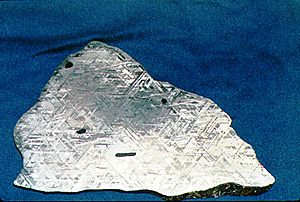William Thomson (mineralogist) facts for kids
Quick facts for kids
Guglielmo Thomson
|
|
|---|---|
| Born |
William Thomson
1760 |
| Died | 1806 (aged 45–46) |
| Nationality | English |
| Occupation | Geologist |
| Known for | Discovery of Widmanstätten pattern |
William Thomson (born in 1760, died in November 1806) was a scientist from England. He studied minerals, which are natural solid materials like rocks and crystals. Later in his life, he lived in Italy and used the name Guglielmo Thomson. He passed away in Palermo, Italy, when he was 46 years old.
Contents
Thomson's Big Discovery: Meteorite Patterns
William Thomson made an important discovery about meteorites. Meteorites are rocks from space that fall to Earth.
How Thomson Found the Pattern
Around 1804, Thomson was living in Naples, Italy. He had a piece of a meteorite called the Krasnojarsk meteorite. He wanted to clean off some rust from it. So, he decided to use a strong liquid called nitric acid.
When the acid touched the meteorite, something amazing happened. Strange, never-before-seen patterns appeared on the metal's surface. These patterns looked like crisscrossing lines and shapes. This was the discovery of what we now call the Widmanstätten pattern.
Sharing the Discovery with the World
Thomson published his findings in 1804. His discovery was written in French in a science magazine called Bibliothèque Britannique. After he died, his work was also published in Italian in 1808. This was translated from his original English notes.
Why It's Called Widmanstätten Pattern
Even though Thomson discovered these patterns first, they are often called the Widmanstätten pattern. This is because another person, Count Alois von Beckh Widmanstätten, also found similar patterns in 1808. He was the director of a porcelain factory in Vienna. He noticed the patterns while heating iron meteorites with fire.
Widmanstätten's discovery was made on his own, without knowing about Thomson's work. However, he did not publish his findings in a paper. He only told his friends and colleagues about it. A scientist named Carl von Schreibers heard about it and named the patterns after Widmanstätten.
Because William Thomson published his discovery first in 1804, he should get the main credit. For this reason, some scientists suggest that the pattern should also be called the Thomson structure.
See also
- Glossary of meteoritics


